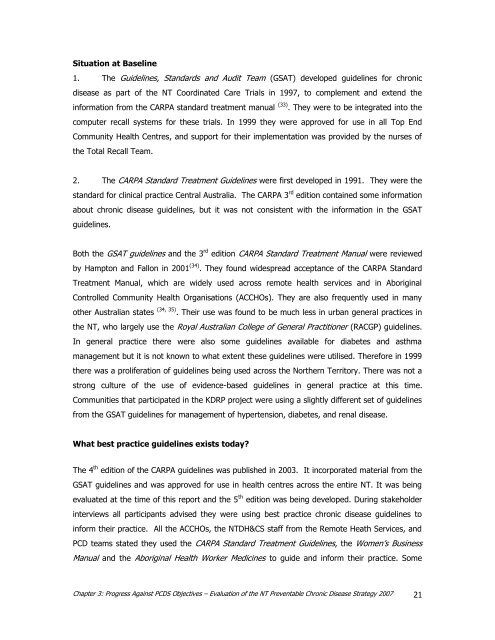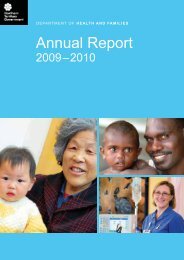PCD Strategy Evaluation 2007.pdf - NT Health Digital Library ...
PCD Strategy Evaluation 2007.pdf - NT Health Digital Library ...
PCD Strategy Evaluation 2007.pdf - NT Health Digital Library ...
Create successful ePaper yourself
Turn your PDF publications into a flip-book with our unique Google optimized e-Paper software.
Situation at Baseline1. The Guidelines, Standards and Audit Team (GSAT) developed guidelines for chronicdisease as part of the <strong>NT</strong> Coordinated Care Trials in 1997, to complement and extend theinformation from the CARPA standard treatment manual (33) . They were to be integrated into thecomputer recall systems for these trials. In 1999 they were approved for use in all Top EndCommunity <strong>Health</strong> Centres, and support for their implementation was provided by the nurses ofthe Total Recall Team.2. The CARPA Standard Treatment Guidelines were first developed in 1991. They were thestandard for clinical practice Central Australia. The CARPA 3 rd edition contained some informationabout chronic disease guidelines, but it was not consistent with the information in the GSATguidelines.Both the GSAT guidelines and the 3 rd edition CARPA Standard Treatment Manual were reviewedby Hampton and Fallon in 2001 (34) . They found widespread acceptance of the CARPA StandardTreatment Manual, which are widely used across remote health services and in AboriginalControlled Community <strong>Health</strong> Organisations (ACCHOs). They are also frequently used in manyother Australian states (34, 35) . Their use was found to be much less in urban general practices inthe <strong>NT</strong>, who largely use the Royal Australian College of General Practitioner (RACGP) guidelines.In general practice there were also some guidelines available for diabetes and asthmamanagement but it is not known to what extent these guidelines were utilised. Therefore in 1999there was a proliferation of guidelines being used across the Northern Territory. There was not astrong culture of the use of evidence-based guidelines in general practice at this time.Communities that participated in the KDRP project were using a slightly different set of guidelinesfrom the GSAT guidelines for management of hypertension, diabetes, and renal disease.What best practice guidelines exists today?The 4 th edition of the CARPA guidelines was published in 2003. It incorporated material from theGSAT guidelines and was approved for use in health centres across the entire <strong>NT</strong>. It was beingevaluated at the time of this report and the 5 th edition was being developed. During stakeholderinterviews all participants advised they were using best practice chronic disease guidelines toinform their practice. All the ACCHOs, the <strong>NT</strong>DH&CS staff from the Remote Heath Services, and<strong>PCD</strong> teams stated they used the CARPA Standard Treatment Guidelines, the Women‟s BusinessManual and the Aboriginal <strong>Health</strong> Worker Medicines to guide and inform their practice. SomeChapter 3: Progress Against <strong>PCD</strong>S Objectives – <strong>Evaluation</strong> of the <strong>NT</strong> Preventable Chronic Disease <strong>Strategy</strong> 2007 21
















